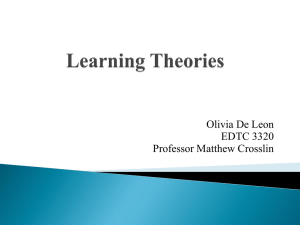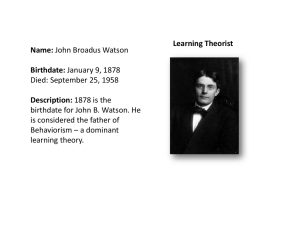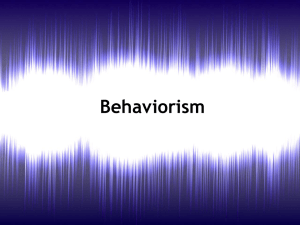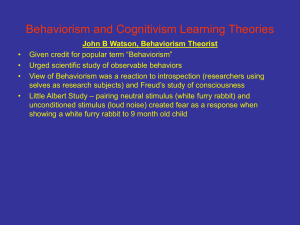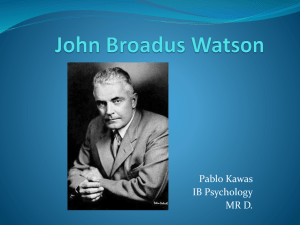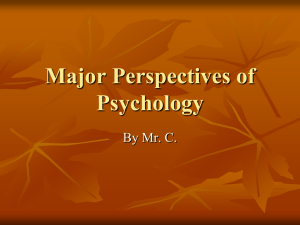slides
advertisement
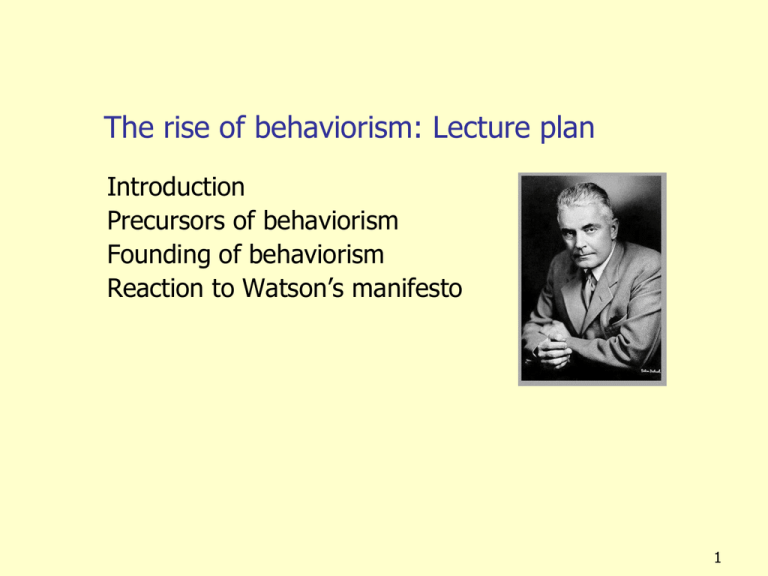
The rise of behaviorism: Lecture plan Introduction Precursors of behaviorism Founding of behaviorism Reaction to Watson’s manifesto 1 The rise of behaviorism: introduction The history of behaviorism can start with describing the functionalist movement, which came before it. The functionalist movement Functionalists were interested in the function of the mind: e.g. What does the mind do? How does it do it? What is the function of consciousness? So they were not particularly interested in the structure of the brain (e.g. the neuronal structure). Functionalists were interested in the application of psychology to everyday social problems. But it was not a formal or unified school of thought. There were several types of functional psychology. It was not so noticeable as other developments. 2 The rise of behaviorism: introduction 1913 – the start of the behaviorist movement with John B Watson (1878-1958) as the founder. He was highly critical of introspectionism – accounts of one’s own thoughts. “Introspection forms no essential part of its methods, nor is the scientific value of its data dependent upon the readiness with which they lend themselves to interpretation in terms of consciousness” (1913). He was also very critical of the functionalist movement. He referred to the followers as “… illegitimate children of introspective psychology” (1925, p1). 3 The rise of behaviorism: introduction Watson only wanted a psychology that studied a science of behaviour dealing only with behavioural (observable) acts. It should also study animals as well as humans. His goal was towards a science of behaviour. He wrote that consciousness had “… never seen, touched, smelled, tasted or moved” (1927, p14) and as such was unprovable. If it were not provable, then this made introspection, the study of consciousness, irrelevant. He said of psychology: “Its theoretical goal is the prediction and control of behaviour.” His beliefs were radically different from previous psychology and is widely regarded as a revolution: it completely rejected previous psychology. 4 The rise of behaviorism: introduction Watson was very forceful in his arguments. He wanted to found a new school of Psychology. Watson was awarded his PhD in 1903 from the University of Chicago. In 1913 he published “Psychology as the behaviorist views it” In 1915 he was president of the American Psychological Association His books were keenly anticipated. Americans in particular loved it as it meant that the fulcrum of psychology had moved from Europe to America. Was he a great person? 5 The rise of behaviorism: its precursors Watson did not originate the basic ideas. He organised and integrated existing ideas. The Zeitgeist (prevailing view of the time) helped Watson to flourish. George Sarton: “creations are very rare, if they occur at all; most novelties are only novel combinations of old elements.” (1936). In other words – most supposed new creations are usually from previous ones. Watson drew on two sources: (a) Philosophy: positivism & mechanism (b) Animal psychology 6 The rise of behaviorism: Philosophical influences positivism The French philosopher Auguste Comte (1798-1857) founded a movement called positivism. He tried to conduct a systematic survey of all human knowledge. Comte proposed that we only know what is objectively observable and beyond debate. All that was speculative or inferential was just illusory and therefore rejected. The only valid data are those that can be verified. 7 The rise of behaviorism: Philosophical influences Positivism Consciousness and introspection cannot be verified, and so should not be part of psychology. So positivism believed that the only valid knowledge is that which can be verified. Therefore, you can only study people’s behaviour, because behaviour can be observed by everyone. 8 The rise of behaviorism: Mechanism “Mechanism” was an idea that was prevalent at the time of the development of behaviourism. It was a doctrine of the 17th century. Briefly, it held that the universe is a machine: all natural processes are mechanically determined and can be explained by the laws of physics. These ideas emerged from the work of the Italian physicist Galileo Galilei (1564) and the English physicist Isaac Newton (1642-1727), among others. 9 The rise of behaviorism: Mechanism How does mechanism relate to psychology? Descartes: the body is composed of physical matter just like any other physical object Therefore the mechanical and physical laws which explain other physical things must explain living things Living things are effectively machines - they move because of external force and NOT voluntary action Humans like machines Positivism and mechanism tell us what we should study and how we should study it 10 The rise of behaviorism: Mechanism In summary: Positivism and mechanism led to the rise of behaviourism. These schools tell us what can be seen, heard or touched. They tell us how we should study it. 11 The rise of behaviorism: animal psychology Animal psychology is the second major influence on behaviorism. Watson was very clear about the relationship betweem animal psychology and behaviorism: “Behaviorism is a direct outgrowth of studies in animal behavior during the first decade of the twentieth century” (1929, p327). This grew out of Charles Darwin’s evolutionary theory which suggested a continuity of functioning between humans and other animals (we’re better but not different). 12 The rise of behaviorism: animal psychology So Watson proposed that we can learn about humans by studying animals. We are now going to examine three notable animal researchers: - George Romanes - Edward Thorndike - Ivan Pavlov 13 The rise of behaviorism: George Romanes (1848-1894) Romanes was a British physiologist who studied animal intelligence and applied Darwin’s theory of evolution to the mind. To do this he used a technique called introspection by analogy. So human introspections are analogous to those that the animal would make. Thus mind processes in animals are the same kind as occur in humans. He experimented on his driver’s cat and showed that it was able to open doors. He thought that through introspection the cat understood a door’s mechanical properties. But he was accused of performing experiments that lacked scientific rigor. 14 The rise of behaviorism: George Romanes (1848-1894) Romanes’ approach is demonstrated by Hans the wonder horse who was a celebrity at the start of the 20th century. He answered questions such as how many straw hats were being worn by men in a circle of people. He answered by tapping his hoof, or by shaking his head in answer to a question such as “how many corners in a circle?” He was owned by Wilhelm von Osten who claimed that he’d taught Hans human intelligence to substantiate Darwin’s claim that humans and animals have similar abilities. 15 The rise of behaviorism: George Romanes (1848-1894) Von Osten’s student Oskar Pfungst eventually worked out in a series of experiments that Hans only gave the correct answer if the questioner knew the answer. If they didn’t know, Hans didn’t know. He noticed that people usually dipped their head slightly after asking a question and raised it after the correct answer given. Hans had unintentionally been conditioned to recognise these movements, especially as Hans was rewarded with sugar after making a correct response. This demonstrated the conditioning effect and the importance of using experiments. 16 The rise of behaviorism: Edward Lee Thorndike (18741949) Thorndike was dedicated to an objective and mechanistic approach to learning. He developed an approach called connectionism, which was about interpreting learning in terms of the concrete connections between stimulus and response. The stimulus and response are the simplest element in animal behaviour. E.g. A dog sits when told “sit!” His theories were based on work conducted using a “puzzle box”. An animal was place in the box and had to learn to escape by pressing a particular latch. The reward for escape was food. 17 The rise of behaviorism: Edward Lee Thorndike (18741949) In the puzzle box behaviour is random. But eventually the animal escapes. On subsequent trials escaping gets faster and faster. This type of learning is called trial and error learning. This is in contrast to the animal being considered to have any insight into the problem. This gradual association between the stimulus (the puzzle box) and the response (escaping) he called instrumental conditioning. 18 The rise of behaviorism: Edward Lee Thorndike (18741949) According to Thorndike, unsuccessful behaviours were stamped out and successful ones stamped in. This became known as the law of effect. In more detail: if a response is made in the presence of a particular stimulus (e.g. lifting a latch) and is then followed by a reward; then the same response is more likely to be made the next time the stimulus is encountered. This is the law of effect. 19 The rise of behaviorism: Edward Lee Thorndike (18741949) An associated law was termed the law of exercise. This law was about how associations increased in strength the more times responses were made (or exercised). Conversely if there is prolonged disuse of a response, then it weakens the association between the stimulus and the response. (Eventually it is extinguished.) Thorndike’s work was central to the formation of behaviorism. Watson himself said that Thorndike’s work laid the foundations of behaviorism. [Little known fact – despite Thorndike’s work on trial and error, he couldn’t learn to drive, even after several attempts.] 20 The rise of behaviorism: Ivan Petrovich Pavlov (1849-1936) Pavlov discovered classical conditioning in 1902, while working on the digestive system of dogs. He was awarded the Nobel prize for his work in 1904. Pavlov noticed that dogs salivated on the arrival of the person who was the feeder or even before they were given food, just at the sound of the footsteps of the feeder. 21 The rise of behaviorism: Ivan Petrovich Pavlov (1849-1936) A typical experiment involved presenting a neutral stimulus (e.g. a bell) at the same time as food was put in the mouth (food = unconditioned stimulus). This was repeated a few times. Eventually the dog would salivate just with the sound of bell. Pavlov called this a conditioned stimulus. When the dog salivated in the presence of the conditioned stimulus (the bell), this was called a conditioned response. 22 The rise of behaviorism The animal research of Pavlov and Thorndike was very important for 3 reasons: 1. They provided scientific methods, as proposed by Watson. 2. They were explaining behaviour without referring to consciousness (like Romanes suggested). 3. If humans are just another species, we should be able to study them the same way. 23 The founding of behaviorism Returning to Watson having covered some of the influences to his work, in his 1913 manifesto “Psychology as the behaviorist views it” he criticised psychology for (a) its goal and subject matter, and (b) its methods of study. Watson suggested that behavioral responses can be classified in 2 ways: (a) they can be learned or unlearned (or innate) and (b) responses can be implicit or explicit. In more detail… 24 The founding of behaviorism Watson suggested that behavioral responses can be classified in 2 ways: (a) they can be learned or unlearned (or innate) and (b) responses can be implicit or explicit. (a) By 1925 Watson believed that all behaviour was learned, even behaviour that appeared instinctive, was really a socially learned response. (b) Explicit responses are those those that are directly observable and overt. Conversely, implicit responses occur inside the organism and are not directly observable (e.g. heart rate). 25 The rise of behaviorism Little Albert (Watson and Raynor, 1920): in a study to demonstrate that emotional responses were actually conditioned, they studied a 11-month-old boy called Albert. They conditioned him to fear a white rat by making a loud noise when he was shown this rat. Soon the rat made Albert afraid. The fear generalised to white furry objects. Watson suggested that this was how adult fears could originate. Watson was very critical of introspection. He asserted that empirically it had failed to deliver. There were no meaningful results. Also, it did not produce results that could be replicated. In addition it had little practical value. 26 The rise of behaviorism: a summary of Watson’s behaviorist goals Psychology is the science of behaviour It must use objective methods It can use animals or human participants We must discard consciousness and instead focus on stimulus-response (S-R) links We should ultimately predict and control behaviour 27 The rise of behaviorism The “new psychology” was based on the principle that humans are like machines made up of similar material. He advocated: Careful observation The experimental method whereby results are treated as samples of behaviour, rather than measures of mental processes Verbal reports: Watson accepted these as aspects of behaviour, just like any other motor response. But he limited this to situations that could be verified (e.g. reporting differences between tones). Conditioned responses needed study: these studied S-R links 28 The rise of behaviorism Reactions to John B. Watson’s manifesto The initial response was apathy (until “Psychology from the standpoint of the behaviorist”, 1919) He said little new but said it angrily, so this gained attention. Older psychologists were already working in the behaviorist framework before Watson’s manifesto (e.g. Pavlov, Thorndike) Introspection was already being criticized Younger psychologists had already accepted the importance of studying behaviour, so the manifesto was accepted as the status quo. By 1920s behaviorism was dominant and a central feature of university programmes. 29
